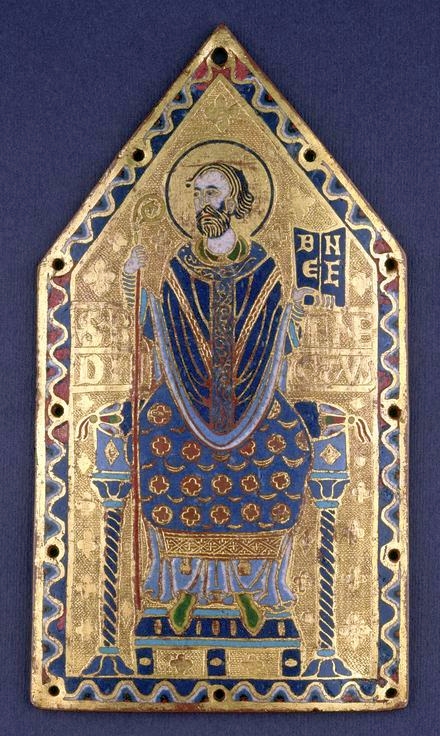Below find notes on the Ordo for the Benedictine Office according to the 1962 rubrics from the first Sunday of Advent to the end of December. You can also find these notes via the Current month's Ordo page on the blog.
Page references are to the St Michael's Abbey editions of the Monastic Diurnal (MD).
For more detailed instructions on how to say the Benedictine Office, please go here.
And you can obtain more detailed Ordo notes here.
28 Nov – First Sunday of Advent, Cl I
MD 4* ff.
Mon 29 Nov – Class III; St Saturninus, Memorial
Ordinary of Advent, MD 9* ff; canticle antiphons, MD 17*; collect, MD 11*; for the com., MD [385].
Tues 30 November – St Andrew, Class II
MD [2]
Wed 1 Dec - Class III
Canticle antiphons, MD 18*.
Thurs 2 Dec – Class III; St Peter Chrysologus,
Memorial
Canticle ants, MD 18*; commem. at Lauds, MD [8-9].
Fri
3 Dec – Class III; St Francis
Xavier, Memorial
Canticle ants, MD 19*; commmem. at Lauds, MD [9].
Sat 4 Dec – Class III
Canticle
ant, MD 19*;Vespers of the following, MD 19* ff.
5 Dec –
Second Sunday of Advent, Class I
MD 22* ff.
6 Dec – Monday Advent wk 2, Class III; St Nicholas, Memorial
Cant ants, MD 26-7*; commem.at Lauds, MD
[9-10].
Tues
7 Dec – St Ambrose, Class III
MD [10] with commem. of the feria, MD 27*.
Wed 8 Dec – Im.
Conception of the BVM, Cl I
MD [13] ff; commem. of the feria, MD 27*.
9
Dec – Thurs Advent wk 2, Class III
Canticle antiphons, MD 27-8*.
10 Dec – Fri Advent wk 2, Class III
Canticle antiphons, MD 28*.
Sat 11 Dec – Sat Advent wk 2, Cl III; St Damasus,
Memorial
MD 28*, and commem. at Lauds, MD [17-8]; 1 Vespers of following,
MD 28* ff.
12
December – Third Sunday of Advent, Cl I
MD 31* ff.
Mon 13 Dec – St Lucy,
Class III
MD [18] ff; commem. of the feria, MD 41-2*.
14 Dec – Tues in Advent wk 3, Class III
Canticle antiphons, MD
42*/AM 221-2.
Wed 15 Dec – Ember
Wednesday, Class II
MD
42-3*.
16
Dec – Thurs in Advent wk 3, Class III
Canticle antiphons, MD 43*.
17 Dec – Ember Friday, Class II
Ants: MD 39-40*; Benedictus and
collect,MD 44*; Magnificat, O Sapientia,
MD 35*.
Sat 18 Dec – Ember
Saturday, Class II
Ants for
the psalms: MD 40-1*; Benedictus antiphon and collect, MD 44*; Vespers
of the following with Magnificat
antiphon, O Adonai, MD 35*.
Sun
19 Dec – Fourth Sunday of Advent, Class
I
MD 48* ff.
Mon 20 Dec – Monday in
the fourth week of Advent, Class II
Antiphons
for the psalms, MD 37*; Benedictus
antiphon, MD 52*; Magnificat, O
Clavis David, MD 36*.
Tues 21 Dec – St
Thomas, Class II
MD [22-3]; commem. of the Advent day at Lauds and Vespers (Benedictus
antiphon, Nolite timere, MD 43*; Magnificat
antiphon, O Oriens, MD 36*).
Wed 22 Dec – Wednesday
in the fourth week of Advent, Class II
Antiphons for the psalms: MD 38-9*; Benedictus antiphon,
MD 53*; Magnificat, O Rex gentium,
MD 36*.
Thursday 23 Dec –
Thursday in fourth week of Advent, Class II
Antiphons
for the psalms: MD 39*; Benedictus antiphon, Ecce completa sunt,
MD 41*; Magnificat antiphon, O
Emmanuel, MD 36*.
Friday 24 Dec – Vigil of the Nativity, Class I
MD 54* ff.
END OF ADVENT/START OF THE SEASON OF CHRISTMAS
(NATIVITYTIDE)
1 Vespers of the following,
MD 58 ff.
Compline:
Marian antiphon Alma redemptoris
henceforward.
Sat 25 Dec – The Nativity of Our Lord, Class I with a
Class II Octave
MD 61* ff.
Sun 26 Dec –
Sunday within the Octave of the Nativity, Class II; Commemoration of St
Stephen, Protomartyr [OF: Holy Family]
MD 77* ff.
Mon 27 Dec – St John
the Evangelist, Class II; Commemoration of the Octave of the Nativity
MD 90* ff.
Tues 28 Dec – Holy Innocents, Class II;
Commemoration of the Octave of the Nativity
MD 97* ff.
Wed 29 Dec – Fifth Day
within the Octave of the Nativity, Class II [In some places, St Thomas Becket,
Class I or Commemoration]
MD 103*.
Thursday 30 Dec –
Sixth Day within the Octave of the Nativity, Class II
MD 103*.
Fri
31 Dec – Seventh Day within the Octave,
Class II; Commemoration of St Sylvester
MD 103-4*.


